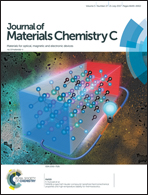Size-controllable and stable organometallic halide perovskite quantum dots/polymer films†
Abstract
Organometallic halide perovskite quantum dots (OHP-QDs) have attracted a great deal of attention because of their high photoluminescence quantum yields (PLQYs, up to 90%) and narrow-band colors. However, precise control of the OHP-QDs' size is difficult and they are unstable under ambient conditions, which limits their usage in applications such as lasers and displays. Herein, we introduce a novel method to prepare size-controllable and stable OHP (methylammonium lead trihalide, MAPbX3, where X = Cl, Br, and I)-QDs/polymer films using polydimethylsiloxane (PDMS) as a template. The MAPbX3 QDs/PDMS films developed in this work are self-standing, flexible, transparent, and retain the photophysical properties of OHP-QDs for at least several months. Moreover, the uniform size of the OHP-QDs results in narrow photoluminescence (PL) emission (full-width-at-half-maximum, FWHM ≈ 20 nm) compared to that of QDs synthesized by a conventional method (≈50 nm). The PL emission peak can be shifted by varying the size of the QDs and also by changing the halide component (Cl, Br, and I), covering a wide range of absorption wavelengths. Furthermore, the higher PL intensity of the larger QDs was confirmed by time-correlated single photon counting (TCSPC) experiments.



 Please wait while we load your content...
Please wait while we load your content...